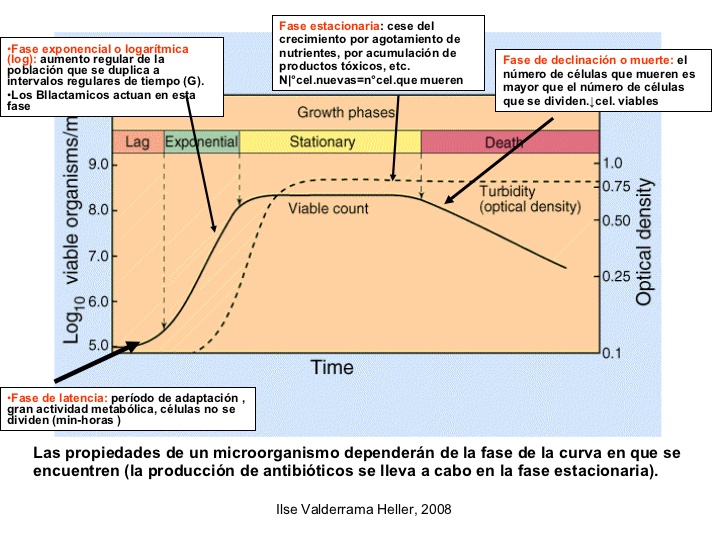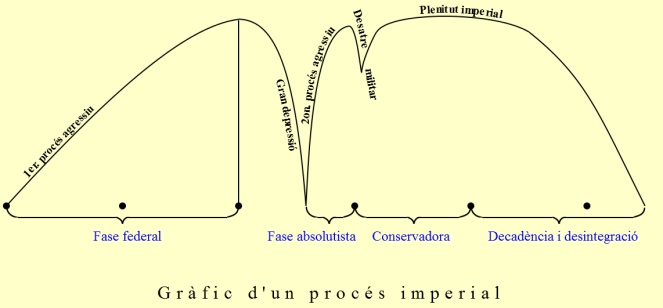E pluribus unum
El maestro Deulofeu tuvo la visión de las sociedades como si fueran un organismo vivo, compuesto de sus múltiples órganos. Y acertó, concentrándose en la evidencia de que todo ser vivo atraviesa un ciclo de vida y muerte; sin embargo, esa imagen lleva tal vez a equívocos si no ampliamos el concepto.
Un cuerpo humano o un organismo es en el fondo la asociación de una multitud de células funcionales y especializadas que interactúan de modo muy complejo, formando por ello un sistema dinámico.
Pero hay muchos posibles. Por ejemplo, los ecosistemas que degradan las aguas residuales.
En función de las condiciones ambientales y los microorganismos presentes, se forman auténticos muestrarios biológicos de alta diversidad, que se expanden a expensas de la materia orgánica; después continúan hasta devorarla por completo y finalmente se devoran a sí mismos.
Esto se puede observar en un típico gráfico de evolución de la población bacteriana en un cultivo. En biología y en ingeniería ambiental, es conocida la siguiente gráfica:

El ramal ascendente de la curva se puede modelizar matemáticamente con las ecuaciones:

De hecho, en un ecosistema cerrado la curva es doble. Cuando parece que todo va a terminar, el sistema se recupera fagocitando los cadáveres de los microorganismos que perecen. Eso hace que se recupere la población y vuelva a crecer, al menos hasta que esa población vuelve a degradarse y decae nuevamente, desapareciendo finalmente.
Por cierto, que las distintas especies que forman el cultivo no se convierten en una especie nueva y homogénea durante el tiempo que dura la vida colectiva, pasando a ser grupos distintos al terminar ese tiempo. Aunque, ciertamente, siempre hay alguna cepa que se impone a las demás y reprime su crecimiento.
Casualmente, un imperio viene a ser algo parecido, un conjunto heterogéneo de organismos (pueblos) creciendo y expandiéndose a costa de un sustrato de recursos.
Deulofeu nos explica el proceso imperial en «naixement, grandesa i mort de les civilitzacions»:
Hem de tenir en compte que ara no es tracta d’un cicle evolutiu, sinó d’un procés biològic…
…La gràfica del procés imperial… segueix una línea continuament ascendent. Arribem a un moment, …segueix un camí descendent …tot ens mena a creure que ha mort.
La facció triomfant,… recupera els territoris perduts.
Arribem a la plenitut imperial… la representem en un traç horitzontal…
Arribant a la fase decandent és quan la gràfica comença a davallar… fins a arribar a la desaparició total de l’Imperi sota domini d’una altr nucli imperial o per l’arribada de l’època de gran fraccionament demogràfic.
Gráficamente:

A propósito de Malthus
Malthus afirmaba que el crecimiento de la población es exponencial (progresión geométrica), mientras que el crecimiento de los recursos es lineal (progresión aritmética). Si la población crece más deprisa que los recursos, se produce una catástrofe y debe regularse la natalidad para que «desaparezcan» aquellos que «sobran». Genial, si no es usted el que se ha de sacrificar ¿verdad?
Su deducción se describe justamente en la ecuación que hemos visto antes: (dN/dt)=kN, donde N es la población. Aquí «k» es una constante, un número; sin embargo, podemos sustituir esa «k» por una función del tiempo que involucre más variables, por lo que la curva explosiva de crecimiento no es indefinida.
Deulofeu nos ha dado una función descriptiva de las variantes a esa curva. También nos ha dado otra respuesta a la cuestión planteada por Malthus: la Naturaleza evita la destrucción dándonos tiempo limitado para realizarla.
Además, hay otros indicios que nos dicen cómo resolvieron estas contingencias en el pasado. Quizás en los números hallemos una aportación a la arqueología de las civilizaciones.
Salud y hasta pronto.
E pluribus unum
The master Deulofeu had a visión of societies as a single organism, made out of its multiple organs. And he succeeded, by focusing on the evidence that every living being faces a cycle of life and death. However, such a picture may mislead us unless we see the whole picture.
A human body or any other organism is indeed an association of multiple functional and specialized cells, interacting in a very complex way. With that, they form a Dynamical system.
But there are many possible ones, like for instance all microorganisms degrading wastewater.
As a function of enviromental conditions and which microorganisms are present, real biological catalogs may develop as an expression of diversity. They spread on the organic matter, then go on until they swallow it almost entirely and finally they feed off themselves.
That can be seen in a typical bacterial growth plot, showing the evolution of their population. In biology and enviromental science, it’s well known the following one:

The ascending branch can be mathematically modelled by using the equations:

In fact, a closed ecosystem follows a double figure. When it looks like everything is done, the system recovers by eating the corpses of the dying microorganisms. That lets population recover and grow again, at least until it degrades again and decays, finally disappearing.
By the way, all different species in the culturing never become a new and homogeneous species during the time that the association lasts, then separating in different groups. Although there is always a more aggressive strain narrowing others’ choices to grow.
By chance, an empire fits quite well with such dynamics, an heterogenous body of organisms (peoples) who grow and spread over a layer of resources.
Deulofeu tells us about the imperial process in «naixement, grandesa i mort de les civilitzacions» («birth, greatness and death of civilizations»):
We must be aware this is not an evolutionary cycle, but a biological process…
…the imperial process plot… follows a constantly raising line. We reach a time when, …it follows a dropping path… everything makes us believe it has dead.
The winning faction, …recovers all territories formerly lost.
We reach the imperial plenitude… we represent it by a horizontal stroke…
When reaching the declining phase, then the plot starts dropping… to the point that the empire collapses and falls under the power of another imperial core, or it enters the time of demographic breaking up.
Grafically:

Regarding Malthus
Malthus stated that population growth is exponential (multiplies geometrically), while resources grow linearly (multiply arithmetically). If population grows faster tan resources, a catastrophe is coming and population must be restricted to make «disappear» all who «are in the way there». Great, if you are not the one to be sacrificed, isn’t it?
His theory is indeed described in the equation above: (dN/dt)=kN, where N means population. Here, «k» is a constant, a number; however, we can replace that «k» by another function depending on time and involving more variables, which makes the explosive plot of growth not to be unlimited.
Deulofeu has given to us a non analytical (formula) description of his curve, only wordly. He has also given us another answer to the question by Malthus: Nature avoids destruction by giving us only a limited surplus of time to make it.
Besides, there are other signs telling us how they could have solved such circumstances in the past. Maybe numbers pour something useful to the archaeology of civilizations.
Stay well and see you soon

https://spaincrisis.blogspot.com/2019/07/brutal-el-banco-de-espana-publica-que.html
Me gustaMe gusta